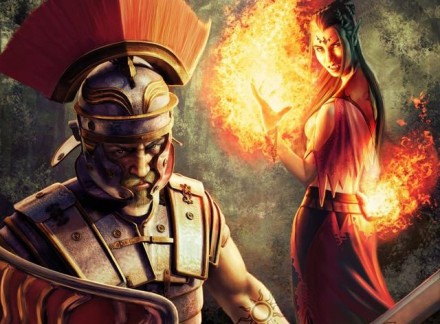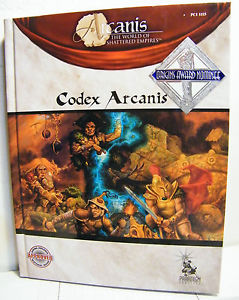
Welcome back guys and girls! We have had an eventful few weeks, and we are hard at work. We hope that you had a chance to look into our last video outlining Arcanis, but if not, don’t worry we are going to do a full review right here on the blog!
What is Arcanis: The World of Shattered Empires?
Arcanis is a game world, in short. It is set on a continent where many different Empires vie for control. They range from the Romanesque Coryani to the serpentine Ssthergoran Empire. They each have a unique history, place in the world, and religious structure.

The above image shows a Coryani Legionnaire and a Ssthergorian

The world of Onara
So, what is this history that is so captivating to you?
Well, it really starts in the original Arcanis books (the Codex Arcanis was the first book). The game started as a d20 Campaign Setting, and in 2012 the makers (Paradigm Concepts) decided to make it into its own game. They changed the rules completely, redid the magic system, and gave the game a update on the history.

The original d20 book
The history is amazing detailed, with a feel that makes it hard to believe that it started out as a simple setting for d20. I will get more into it below, during the actual review.
So, tell us more!
This game is one of the games that I eyed for a while before I picked it up (I would advise picking up the PDF, since it is much cheaper than the hard copy [24.00 vs 60]). It had intrigued me since I had read the d20 version, and I was wondering if the new system would carry the spirit of the original. I was not disappointed.
The Review!
Okay, so now the review. We have to start at a big downpoint in the new core: The lack of information about the history in the old Arcanis books (and the lack of a map!). They remedied this by giving free copies of the Codex Arcanis away in PDF. Simple fix, download that book and you will have all the information you will need.
The Codex of Arcanis
The game book starts off fast, and jumps right into the world. Each culture has its own section. There are 14 different cultures to deal with, and the religions get their own spread as well. That is a lot of information to put out there, and it makes it understandable why they left out the old information.
So, who are these cultures?
We have the following cultures:
The Abessian Dominion — These guys are a lot like late Imperial Egyptians.
The Free City-States of Almeric — These guys are the Holy Roman Imperials
The Altherian Republic — These guys are the Northern Africans.
The Blessed Lands — The Site of the First City.
The Theocracy of Canceri — A former provice of the Coryani Empire.
The Coryani Empire — The Imperial Romans.
The Dwarven Enclaves — Cursed Giants who forsook humanity in its time of need
The Elorii Nations — Elf-like elemental worshippers.
The Hinterlands — The Mongols of the World. They come from all different cultures.
The League of Princes — The primary domain of the Kio.
The Kingdom of Milandir — These guys are like the Middle-English.
The Pirate Islands — What does this sound like?
Ssethergoran Empire — A snake-like culture that is bent on domination of the world.
The Unsealed Lands — The lands where all the Infernals are banished to.
Ymandragore — The kingdom of the Sorcerer-King. The only place that sorcerers don’t degrade by casting spells.
Religions get a nice coverage here as well. The pantheon of man is given the most treatment, since it is the pantheon that most people worship. There are other churches, however. They also have:
The Church of the Dark Trimuvirate
The Milandric Orthodox Church
Belisarda and The Four Elemental Lords
The Matriachy of the Fire Dragon
Elemental Worship and Animalism
Infernal Cults
Myrandtian Pantheon
The Codex of Heroes
This section starts with an overview of the system. The system is rather basic: Roll 2d10 + Attribute Die + Skill Modifiers. You then compare that to a Target Number. It explains how the Attribute Die can explode (roll the max and pick it up, roll again).
There is, of course, critical success and critical failure. Roll a 20 on the 2d10, crit success. Roll 2, and it is a failure.
Just like in d20, bonuses from similar sources don’t stack.
It also goes through when to make rolls. There is also a section on using Passive Action Rolls. These are normally used to overcome an unaware or absent character.
Character creation is the meat of this section:
Choose an archetype — there are four of them: Arcane, Divine, Expert, Martial
Determine Your Attributes — you get a number of points to spend on these. The default is 40 points.
Choose a Race — there are a lot of races to choose from: Dark-Kin, Dwarf, Elorii, Gnome, Human, Kio, Ss’ressen, and Val
Background — you choose what you did before you became an adventurer
Skills — choose skills here. You get points equal to your Passive Logic + Passive Reason + 3
Talents — choose two talents (unless you want a flaw, in which case you get 3).
Equipment — buy your starting gear, in addition to anything you get from your background
That is that.
Codex of Conflict
This is the combat section. It is really in depth but I will try to give you a one paragraph description of the major parts:
Combat starts with the initiative roll. Pick up a number of d10s equal to your passive Agility. Take the lowest roll. That is the first tick you can act on. Each action has a speed. Add the speed to the current tick, and you can act again on this tick.
Initiative is based on a “clock” with 12 ticks. It does not reset at the end of a round, instead it is circular. For example, you are on tick 10. You take an action with a speed of 4. You would act again on tick 2 of the next round.
The rules cover everything you will need. Movement, maneuvers, weapon tricks, and even falling.
Codex of Magic
This is an amazing section as well. It covers the different types of magic, the way to cast spells, and even the spells themselves. There is, again, too much to deal with in a simple review. All in all, though, it is a really deep system!
Overall Impressions
I am giving this game a 8/10! The book is well-laid out, and it is very well made. The system is simple but elegant. The art is good, and the flow of the book makes sense. I would recommend this to anyone looking for an alternate fantasy RPG.
